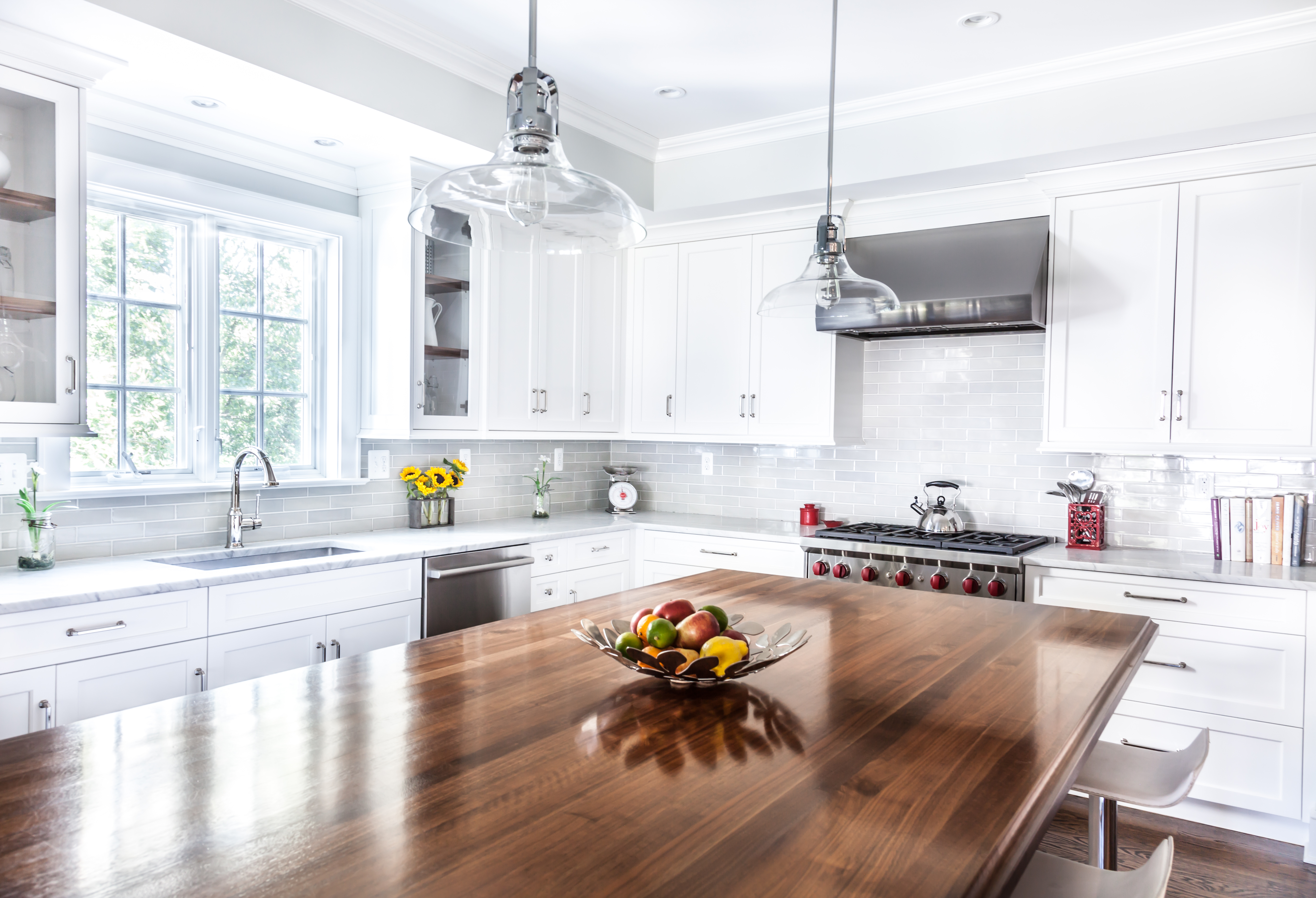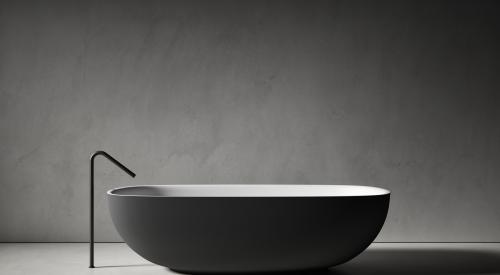The future of kitchen countertops may very well be under your feet. Constructed from up to 78 percent recycled glass, sealed, and diamond-head polished, countertops from TREND Transformations have recently found a unique commercial application: as flooring at London’s Heathrow Airport and Victoria’s Secret retail locations around the world. The scratch-resistant, non-porous surfacing can incorporate mother-of-pearl, porcelain, seashell, and stone aggregate into its formulation, and offers durability and strength greater than quartz or granite at just a quarter-inch thick.
“As flooring, our recycled glass retains its finish given extremely heavy commercial traffic,” says TREND Transformations regional brand director Jason Langford. “As a material for kitchen countertops, it speaks to the qualities that are going to drive alternative products to quartz for homeowners: the ability to be on-trend but with the durability and functional aspects to live their lives.”
Fabricated with up to 78 percent recycled glass, the company’s solid surfacing can incorporate aggregates such as semi-precious stones, mother-of-pearl, seashells, and more. The product is scratch resistant and low maintenance, and can be heat-bent to right angles during fabrication for waterfall edges.
Indeed, as quartz continues its reign as a countertop of choice, alternative materials such as glass, metals, and wood are giving stone a run for its money. Often manufactured using recycled, recyclable, or renewable resources, up-and-coming surfaces highlight homeowners’ desire for sustainability even as they deliver high-impact visual aesthetics and high performance.
Susan Brisk, a principal of Boston-based Euro-Plus Design who teaches classes in kitchen and bath materials and estimating at Boston Architectural College, says market swings have alternated between homeowner desires for great looks or low maintenance, drivers that have converged from an either/or decision to an expectation.
“There have been many alternative products to quartz that look lovely but have a lot of upkeep,” Brisk says. “But homeowners are no longer selecting new options that are exciting but require a high level of maintenance, and as a designer you would never go out of your way to recommend a product that is not going to stand up.”
The company manufactures handcrafted custom kitchen and bath countertops, wet bars, and butcher block in a range of domestic and sustainable wood species, including black walnut, American cherry, and reclaimed beech. Finished surfaces are 100 percent waterproof and are available in distressed and nondistressed profiles.
Between the two extremes of ornate statement kitchens and modern/classic contemporary, counter selection will also remain critical as a primary design element. “They will always bring your eye around the room and create room flow and traffic patterns, playing a big role in the planning of a space and the angle and shape of where you walk and where your eye is drawn,” Brisk says.
Therein lies the partial failure of stone as a prominent design element: a monolithic product that has opened the popularity vote to new materials. “The big trend in kitchen design in today’s era is the mixing of surfaces as a reaction to the huge kitchen, huge island, and everything [being] stone, ultimately creating a mausoleum effect,” says Denise Grothouse, chief brand officer for Grothouse Lumber Co., a maker of wood countertops. “The problem with stone, especially on an island, is that it’s cold to the touch, whereas wood is warm and it absorbs sound, while stone reflects it.”
Noir Bio-Glass appears completely opaque until backlit by LEDs, making the 100 percent recycled tinted glass translucent. Also available in white, light green, dark green, blue, and amber, the layered glass material is manufactured into slabs for countertops and other decorative surfaces.
Different species of wood have varying hardness levels, with Brazilian cherry providing a nearly scratch-less density. Grothouse says a growing number of customers are choosing pre-distressing and hand planing. The company also has a 100 percent waterproof finish and still sees a demographic of customers who want to cut and prepare food directly on the countertop.
Founded in 2003, IceStone fabricates countertops from a 70/30 blend of recycled glass and concrete, and extends sustainability to its factory. “To be as green as possible is our mission,” says IceStone marketing manager Derek Hawkins. “We have seen a radical shift in homeowner preference for something sustainable not as a trend but as an ideology and lifestyle informing all of their design choices, so we’ve created a Cradle to Cradle [Certified] product that we hope even beyond its use will be recycled.”
This glass-and-concrete composite countertop features 70 percent recycled glass by weight. Free of petrochemical and plastic resins, the product is scratch and UV resistant, and is available in 16 finish tones, including Alpine White, Forest Fern, Gotham Gray, and Tuscan Sunset. Fabricated slabs are 52 1/2 inches wide by 96 1/2 inches long, with a 1 1/4-inch nominal thickness. The material is NSF 51 certified, is recyclable, and is Cradle to Cradle Certified.
As homeowners search for the next big thing, Brisk is seeing a return to laminates in entry-level projects. With a wider range of products making the grade in terms of durability and low maintenance, creativity will drive the trends for quartz alternatives. TREND Transformations has formed partnerships with Skyy vodka and Budweiser beer to crush colored glass into recycled countertops, but Langford admits that white and gray color preferences are “the new black” among consumers.
“It depends on where in the country you are doing things and what’s popular,” agrees Brisk. “Having more than one countertop finish is on the rise as mixing heights and mixing mediums is very in, so most of all you need to look at counters and surfaces not as an accent but as an anchor of things of interest.”
The company’s ultra-compact sintered product is the next wave of solid surfacing. Able to take on the appearance of various materials, the product is durable, heat resistant, and non-porous. Trillium (shown) replicates the look of oxidized steel.
Sintered stone surfacing is manufactured in Castellon, Spain. A 100 percent natural product made from clay, feldspar, quartz, silica, and other mineral oxides, it includes up to 52 percent recycled material and simulates natural stone. A high-pressure, 2,200-degree F fabrication process allows for thin, large-format slabs without sacrificing performance.
This story originally appeared in the Jan/Feb 2017 issue of PRODUCTS magazine. See the print version here.



















